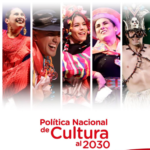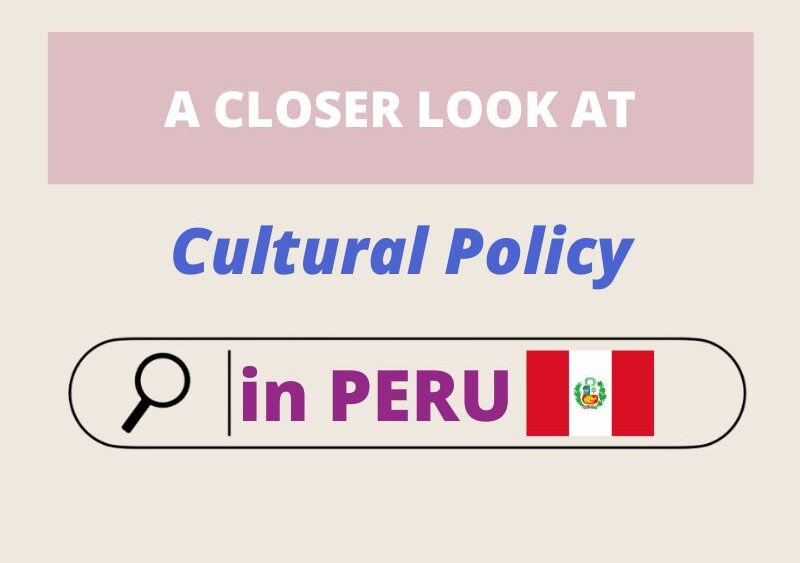The Compendium see its main mission in informing, reporting and understanding cultural policies as well as exchanging on good practices in this area. In 2025, we will start to provide also some views and insights of cultural policies outside of Europe. This new Compendium feature named “A Look at Cultural Policy” and will focus in its first edition on Peru.
 Our special thanks for their efforts and commitment go to the Peruvian cultural policy experts:
Our special thanks for their efforts and commitment go to the Peruvian cultural policy experts:
Enrique Banús, Maria Fernanda Flores, Maria Llana and Maria Alejandra Salgado.
“A Closer Look at Cultural Policy” in Peru
About the ministry and its history
In 1970, UNESCO first convened governments to discuss cultural policy. The final document of the first World Conference on Cultural Policy in Venice, attended by 88 member states, called for the establishment of fixed budgets for culture in national budgets. Inspired by this, many countries set up government institutions with responsibility for culture. In Peru, a National Institute of Culture (Instituto Nacional de Cultura) was created the following year, although there was still no Ministry of Culture. It was only in 2010 that it became a ministry (at the instigation of a president who admired France). This marked the end of a long history dating back to 1962, when a Casa de la Cultura was created during the period of military rule.
Peru is a semi-presidential republic. 34 million people live in an area of 1.3 million square kilometres. It has a nominal gross domestic product of $280 billion, ranking it 49th in the world. The Ministry of Culture, described in detail below, is one of 18 ministries in the government of President Dina Boluarte. A budget of US$198.25 million is planned for culture in 2024, representing 0.3% of the total budget. The current minister, Alfredo Valencia Gibaja, is an independent lawyer – most members of the government do not belong to any political party – with extensive experience in heritage issues and e has previously held numerous positions within the ministry.
The framework: the cultural policy strategy “Política Nacional de Cultura 2030”
 Strategic documents pertaining to cultural policy have been published in Peru since the 1970s, including in 1977, 1983, 2002 and 2012. Following an extended period of preparatory work, a document was published in 2020 that was intended to function as a guideline for the cultural policy of the future: the “Política Nacional de Cultura al 2030” (PNC). This document represents a departure from earlier, often exuberant approaches by virtue of its foundation in a concrete analysis and definition of objectives. A salient problem identified in the document is the limited realisation of cultural rights, with the objectives (supported by indicators) encompassing diversity, participation in cultural life, the sustainable development of the cultural and creative industries, heritage protection, and governance. However, the proposed timeframe, which has been further reduced by the impact of the pandemic, is inadequate to achieve the ambitious goals set forth. The question of the ministry’s adherence to its own strategy remains unanswered, as recent activity reports scarcely mention it, instead focusing on the following three areas in detail:
Strategic documents pertaining to cultural policy have been published in Peru since the 1970s, including in 1977, 1983, 2002 and 2012. Following an extended period of preparatory work, a document was published in 2020 that was intended to function as a guideline for the cultural policy of the future: the “Política Nacional de Cultura al 2030” (PNC). This document represents a departure from earlier, often exuberant approaches by virtue of its foundation in a concrete analysis and definition of objectives. A salient problem identified in the document is the limited realisation of cultural rights, with the objectives (supported by indicators) encompassing diversity, participation in cultural life, the sustainable development of the cultural and creative industries, heritage protection, and governance. However, the proposed timeframe, which has been further reduced by the impact of the pandemic, is inadequate to achieve the ambitious goals set forth. The question of the ministry’s adherence to its own strategy remains unanswered, as recent activity reports scarcely mention it, instead focusing on the following three areas in detail:
Focus: Cultural heritage
Peru’s cultural monuments are world-famous, and the country has a long-standing commitment to their protection. The first decree to protect archaeological cultural assets was issued just one year after the declaration of independence in 1821. This decree ordered the creation of the National Museum and prohibited the removal of archaeological cultural assets without the government’s permission. This commitment to protecting these cultural treasures has continued over the decades, often linked to the idea of a national identity. Numerous legal provisions and measures have gradually formed a dense “care network” for this cultural heritage. The Ministry of Culture assumes this priority with provisions for the mandatory registration of all ceramic, metal or textile pieces from pre-Hispanic times and with concern for the Wak’a or Huacas of the Incas and other cultures. It is quite a challenging task, as there are thought to be more than 300 such sites around Lima alone, of which only a small number are said to be open to visitors. In 2023, 73 of these monuments were renovated. The Qhapaq Ñan, the Inca trade route across several countries, is of particular interest.
The General Directorate of Museums is responsible for managing 56 museums across the country. It is also responsible for registering all archaeological cultural assets. This is to prevent their illegal export. However, every year, such goods are identified mainly through auction catalogues and then returned with the help of the Ministry of the Interior and Foreign Affairs, embassies and Interpol: 316 cultural goods in 2022, and 400 in 2023.
Many associations care for cultural monuments on a voluntary basis, and the Ministry provides support primarily through educational measures. The possibility of mobilising private funding for heritage protection, motivated by fiscal incentives, is developing very gradually. A decree was issued in 2015 to facilitate this. However, this was met with strong resistance, especially in the south around Cusco. The false but effective argument was that the state wanted to privatise cultural monuments, and this opportunity was lost. However, the ministry, in collaboration with the state agency for the promotion of private investment, has recently revived this initiative, albeit in a limited capacity, with the aim of invigorating commercial activity in the immediate vicinity of six “huacas” in the Lima region.
The responsibility for cultural assets from the times of the Viceroyalty or the Republic should largely lie at municipal level. In Lima, a long-standing campaign has been generously funded, allowing for the repair of several buildings and squares. Similar projects are currently being developed for Cusco, Arequipa, Trujillo and Ayacucho, but such activities are lacking in many other cities.
Focus on cultural and creative industries and arts
A deputy minister is responsible for cultural and creative industries and arts promotion. They are supported by six departments and oversee the five national ensembles and the modern, prestigious national theatre with more than 1 400 seats.
A perusal of the latest annual reports reveals an extraordinary variety of activities in all conceivable areas of cultural policy. A significant part of this work is carried out through the “estímulos económicos”, which means financial support according to programmes with selection procedures. Books and, above all, film enjoy special attention, as shown by the 23 existing programs for film promotion; Peru promotes the domestic film industry – and already with some success in regional film production – that which was produced outside of Lima.
There is an almost unmanageable number of measures for the promotion of culture and the cultural and creative industries. Nevertheless, the question of concept orientation arises. Cultural policy is under scrutiny from various angles: some see it as neoliberal and solely focused on commercialism, while others regard it as left-wing ideological. The term ‘eclectic’ is perhaps more appropriate, given the complexity of the situation. The recent protests regarding tickets to Machu Picchu have led to the resignation of a minister who had been in post since 2022, with three female and two male ministers following suit.
Focus on interculturality
Even during the debates on the creation of a Ministry of Culture, Parliament insisted on the intercultural aspects. This was a logical move, given that 48 languages other than Spanish are spoken in the country. The second department within the Ministry of Culture is wide-ranging. The department’s primary objective is to ensure linguistic diversity in all administrative offices. Ships and small planes are utilised to deliver the state administration to even the most remote places. The “Peru without Racism” initiative and translations into various languages are part of its work, as is the promotion of the Afro-Peruvian population.
One focus is on safeguarding the rights of indigenous peoples, to which Peru has committed itself under Convention 160 of the International Labor Organization (ILO) such as the right to be consulted and involved. In 2023, the Ministry initiated 14 procedures in this regard. The territorial administration of the PIACI, i.e. the indigenous isolated or barely contacted population, is also part of the remit. However, only less than 1 percent of the Ministry of Culture’s budget is used for all of these actions. The greatest threat to cultures in the Amazon region in particular is the exploitation of the jungle for purely commercial reasons.
»Plural is beautiful«
In a federal state, decentralisation is not a goal. In a state like Peru, which has long been highly centralized, it is rather essential. Peru’s 1993 constitution clearly recognises decentralisation as a central principle, and the transfer of responsibilities to regional and municipal governments took place in the first decade of the century. However, very few regional governments and municipalities have a structured cultural policy, although the ministry does provide support, although not with much enthusiasm. While cultural activities are carried out at the municipal level and some cultural institutions such as libraries, theatres and auditoriums are maintained, there is often no concept beyond one-off activities. The annual presentation of public sector budgets reveals that this is not due to a lack of financial resources. The annual budget always includes investments in the area of culture, but a large proportion of this money is not spent and is returned to the Ministry of Finance.
Moving forward, we should focus on cultural policies in Peru, not just cultural policy as a whole. We need to look at this in terms of specific programmes and in relation to the local authorities involved.
The conclusion is clear:
It is clear that Peru has the prerequisites for a cultural policy. The Ministry of Culture also acts in a variety of ways within the framework of a broad mandate. The focus is on protecting the rich archaeological cultural heritage, which is scattered across the vast and sometimes inaccessible territory. The ministry also promotes numerous activities in various fields. The question remains: would less be more? A concept-based cultural policy would make more sense.
It is clear that the major guidelines of a landmark document such as the cultural policy strategy “Política Nacional de Cultura 2030” do not shape the “real life” of the ministry. The Ministry’s cultural policy, as outlined in the 2022 or 2023 annual report, is clearly lacking in its response to the necessary focus on the realization of cultural rights – or any other unifying guideline.
Finally, it is important to briefly mention another aspect that extends beyond the scope of this article: the relationship between culture and tourism. Peru is an attractive country for tourists (particularly cultural tourists), although concentrated on a few destinations mainly in the south of the country (keyword: Machu Picchu), while in many places cultural monuments are difficult to reach and have infrastructural deficiencies and are still awaiting exploration, especially by domestic Peruvian tourism, which would certainly have very positive economic and social consequences. This is also related to the deficit already described, namely that the focus is always on a rather centrally oriented cultural policy, while regional or local cultural policies have so far been less developed.


Comments are closed.